Biodiversity COP15: global targets, local action
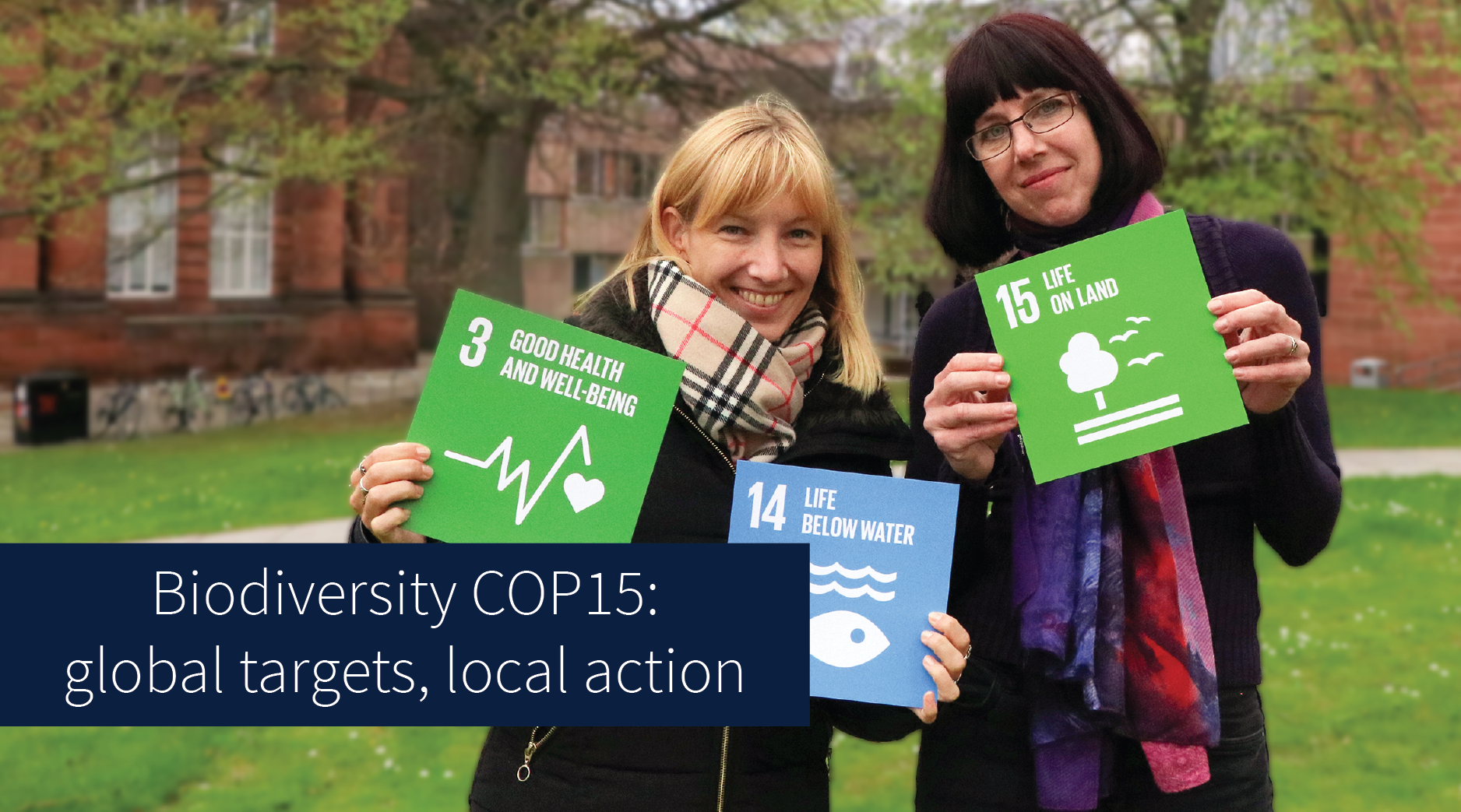
Elizabeth Vander Meer, Research & Policy Manager (Climate Resilience and Biodiversity), and Kim Vender, Biodiversity and Climate Resilience Projects Officer, from the Department for Social Responsibility and Sustainability tell us about the outcomes of Biodiversity COP15 and how they affect the University.
At COP15 in December 2022, after years of negotiations under the United Nations Convention on Biological Diversity (CBD), 196 parties reached a milestone agreement: the Post-2020 Global Biodiversity Framework.
It was supposed to be reached already two years earlier to ensure a seamless succession to the 2011-2020 Aichi Biodiversity Targets but as with so many other issues, Covid-19 got in the way and delayed the process. The pandemic was also given as the reason for the biodiversity COP not to be held in Kunming, China, but in Montreal, Canada. China, however, still had the COP presidency, which is why the summit’s outcome is now called the Kunming-Montreal Agreement.
Despite being delayed and moved around, the CBD COP15 attracted a lot of attention from governments, civil society, and businesses. The latter even showed the greatest interest in and representation at the COP than ever before, according to Carbon Pulse.
COP15: World reaches global agreement on biodiversity
What is Biodiversity and why should we care?
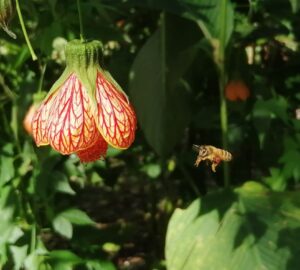
Next to Climate Change and Sustainable Development, Biodiversity is increasingly becoming a buzzword that gains more and more traction with people. Broadly speaking, the term describes the state of the variety of life on Earth, ranging from humans to animals, plants, fungi, and microorganisms like bacteria. It also includes the variety between different ecosystems on land and seas, variety within species, and even genetic diversity.
After so many years in the shadow of climate change negotiations, nature recovery edged closer to the spotlight with the adoption of the Post-2020 Global Biodiversity Framework. Political leaders have long recognised the need to address biodiversity loss. After all, they have been meeting since the 1992 Rio Earth Summit to find ways to confront it.
Now, it seems as if they increasingly feel the urgency to act. In the COP15 agreement, parties acknowledged that “biodiversity is deteriorating worldwide at rates unprecedented in human history” (GBF Section A, p.4). They further acknowledge that protecting biodiversity is imperative given that it is “fundamental to human well-being and a healthy planet, and economic prosperity for all people”.
We depend on it for food, medicine, energy, clean air and water, security from natural disasters as well as recreation and cultural inspiration, and it supports all systems of life on earth. (Global Biodiversity Framework, Section A, p.4).
Importantly, the overall narrative in the public debate is incrementally changing, too, moving from acknowledgement of a “climate emergency” to a “poly-crisis” and from being more sustainable relative to the previous year to “absolute sustainability”. Adjusting the narrative in that way is important for recognising the interlinkages of climate change, biodiversity, sustainable development, and our planet’s ecological boundaries. A positive outcome of the negotiations is the clear link that was established between the protection of biodiversity and the 2030 Agenda for Sustainable Development (see GBF, Section D, p.7).
‘Polycrisis’ may be a buzzword, but it could help us tackle the world’s woes
Questions about absolute sustainability
The outputs of COP15: 2050 vision and 2030 mission
The overall vision of the Post-2020 Global Biodiversity Framework is the same as what was set in 2010 for the previous Strategic Plan 2011-2020 for Biodiversity and the Aichi Targets: “a world of living in harmony with nature“ where:
By 2050, biodiversity is valued, conserved, restored and wisely used, maintaining ecosystem services, sustaining a healthy planet and delivering benefits essential for all people. (GBF, Section F, p.7)
Key Elements of the Strategic Plan 2011-2020, including Aichi Biodiversity Targets
The mission statement is covering the decade until 2030 to put countries on the right trajectory towards the 2050 vision. The mission is:
To take urgent action to halt and reverse biodiversity loss to put nature on a path to recovery for the benefit of people and planet by conserving and sustainably using biodiversity, and ensuring the fair and equitable sharing of benefits from the use of genetic resources, while providing the necessary means of implementation. (GBF, Section F, pp.7-8)
There are, however, some slight changes to 2010. The current mission aims at not only halting but also reversing biodiversity loss to help nature recover. Even though ecosystem restoration had been mentioned in 2010, it is put front and centre for the coming ten years. The announcement of the UN Decade on Ecosystem Restoration 2021-2030 (see #GenerationRestoration) as a response to a call by over 70 countries already in 2019 clearly illustrates that.
About the UN Decade on Ecosystem Restoration
Another difference to 2010 is the omission of the aim to mainstream biodiversity issues and values into national accounting and planning systems. Mainstreaming the value of biodiversity was part of the first strategic goal in the previous plan and was reportedly one of the few targets that countries made steady progress on (cf. Global Biodiversity Outlook 5 – Summary for Policymakers, 2020, p.4).
In Montreal, countries not only decided on an ambitious mission to halt and reverse biodiversity loss by 2030, but also an action framework to give substance to that mission statement.
Global Biodiversity Outlook (GBO)
Framework for implementation: Four Goals for 2050 and 23 Targets for 2030

Fox at Peffermill
The Kunming-Montreal Agreement breaks down the 2050 vision into four goals and the 2030 mission into 23 targets. By 2050,
- all ecosystems are supposed to have enhanced or restored integrity, connectivity, and resilience; the human induced extinction of threatened species is halted while the extinction rate of all species is reduced tenfold; and the genetic diversity of all species is maintained.
- biodiversity should be sustainably used and managed, to support the achievement of sustainable development;
- the benefits from the utilisation of genetic resources and traditional knowledge are shared fairly and equitably;
- and all countries, but especially developing countries, should have adequate means to implement their actions, such as money, scientific knowledge, and technology.
To reach these goals, countries negotiated 23 targets. Some key targets to be reached by 2030 that are most significant to University actions are:
- Effective restoration of at least 30% of degraded ecosystems
- Effective conservation and management of 30% of land and 30% of seas
- Reduce pollution risks and impacts from all sources, reducing the overall risk from pesticides by half
- Restore and enhance ecosystem function through nature-based solutions and ecosystem-based approaches
- Increase the area and quality of urban green and blue spaces
- Equitable representation and participation of Indigenous peoples and local communities
Some highlights
30×30
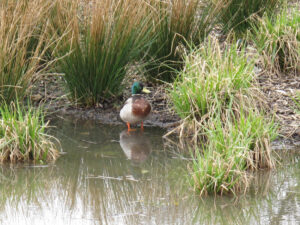
Duck at Easter Bush
Amongst the most celebrated targets is the so-called 30×30 target, which asks countries to put at least 30% of land and 30% of ocean areas under protection by 2030. According to the Global Biodiversity Outlook (2020), the area under protection increased between 2000 and 2020 from 10% to 15% (land area) and from 3% to ca. 7% (sea area).
The protection of key biodiversity areas, where the level of biodiversity is particularly high, has also increased from 29% to 44% during that time. The 30% target is a good one but concerned experts highlight it needs to be the right 30%, namely where biodiversity is higher, for it to have the desired impact; at the same time, so called “cold spots” for biodiversity will also have valuable ecologies that require protection. Moreover, it is one thing to protect an area but another to manage it well, which is why the “effective conservation and management” target is equally important.
We need to protect and conserve 30% of the planet: but it has to be the right 30%
Funding for biodiversity
Another important outcome of the CBD COP was the decision to scale up funding for biodiversity and channel it to where it is needed most through a new Global Biodiversity Framework Fund under the Global Environment Facility (GEF). As part of the “means for implementation” of national and local biodiversity actions, money is considered crucial for timely achievement of the 2030 targets, especially in developing countries.
It was a difficult issue during the negotiations and countries are still ambivalent regarding the aim of mobilising $200bn by 2030 from a wide range of sources, while at least $20bn per year by 2025 and $30bn per year by 2030 should come from industrialised countries. Even in the final plenary, the Democratic Republic of the Congo voiced reservations about the funding facility and the sources of funding but the Kunming-Montreal Agreement was gavelled through nevertheless. The concerns are understandable given that the overall calculated “biodiversity finance gap” amounts to $700bn per year (GBF Section G, p.8).
Overall success
Overall, however, the CBD COP15 can be deemed a success. In a press statement, then Director General of WWF International, Marco Lambertini, assessed that:
Agreeing a shared global goal that will guide collective and immediate action to halt and reverse nature loss by 2030 is (…) a win for people and planet. It sends a clear signal and must be the launch pad for action from governments, business and society to transition towards a nature-positive world, in support of climate action and the Sustainable Development Goals.
Global deal to reverse nature loss by 2030 agreed, but immediate action and funds needed to deliver
How the University of Edinburgh is delivering on biodiversity protection
The University of Edinburgh is already acting on targets set out at COP15 through a programme of operational work, but also a whole institution approach that encompasses research, learning and teaching, partnership working and supply chains.
Land restoration, mapping and monitoring
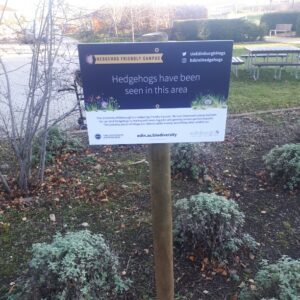
“Hedgehogs have been seen in this area” sign
Carbon sequestration investment, to restore peatland and woodland, will contribute to Scotland’s 30X30 target, while we will also set a target to contribute on our local land in Edinburgh, through the use of a green infrastructure mapping tool that scores the value and quality of green and blue spaces for biodiversity, and provides us with a means of monitoring progress; use of the tool will align with 30X30.
Green and blue infrastructure mapping on our campuses and in the city also makes visible the value of nature for adapting to climate change impacts, with the mapping tool capturing surface areas and the importance of permeability for absorption of rain water and cooling from tree cover (leaf area).
Equally, mapping of campus and city sites allows us to see how well connected or not habitats are for species, allowing us to focus on those areas that need better connectivity. In all of these cases, we work and will continue to work in partnership within the city and beyond, linking up with other projects and programmes in this area.
Pesticide and herbicide trials
Our department has been working on a pesticide and herbicide use project, with input from living lab student projects since 2019, and will trial other methods as part of upcoming pilot projects. This programme of biodiversity actions engages with members of Edinburgh communities, private businesses, NGOs and the local council, as well as students and academics within the University to inform us as we go forward.
Valuing life
We value biodiversity and all that this encompasses, considering care for other species and nature, also beyond use value and in terms of the value of other life in and of itself. We hope to increase our commitment to protecting biodiversity alongside climate change actions, embracing the following vision:
The University will protect existing biodiversity on campuses and enhance opportunities for biodiversity by taking a holistic approach that prioritises our interactions with wider communities of organisms, including humans, and dynamic landscapes.
Topic: Biodiversity at the University of Edinburgh


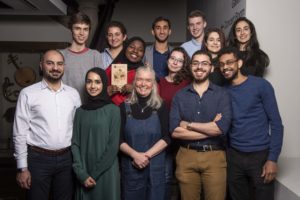


Recent comments